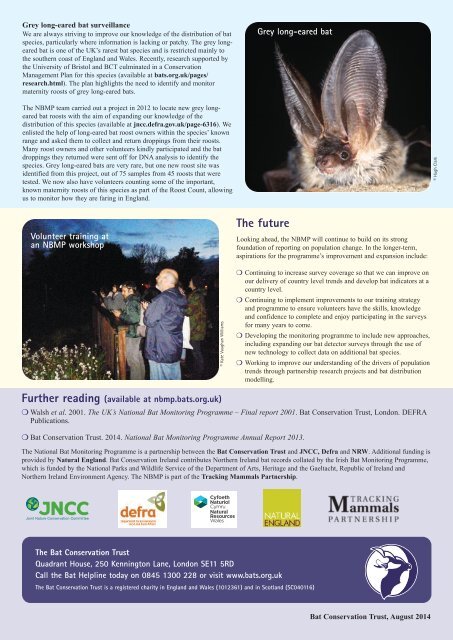The state of the UK’s bats 2014
NBMP_Summary_2013_web
NBMP_Summary_2013_web
Create successful ePaper yourself
Turn your PDF publications into a flip-book with our unique Google optimized e-Paper software.
Grey long-eared bat surveillance<br />
We are always striving to improve our knowledge <strong>of</strong> <strong>the</strong> distribution <strong>of</strong> bat<br />
species, particularly where information is lacking or patchy. <strong>The</strong> grey longeared<br />
bat is one <strong>of</strong> <strong>the</strong> <strong>UK’s</strong> rarest bat species and is restricted mainly to<br />
<strong>the</strong> sou<strong>the</strong>rn coast <strong>of</strong> England and Wales. Recently, research supported by<br />
<strong>the</strong> University <strong>of</strong> Bristol and BCT culminated in a Conservation<br />
Management Plan for this species (available at <strong>bats</strong>.org.uk/pages/<br />
research.html). <strong>The</strong> plan highlights <strong>the</strong> need to identify and monitor<br />
maternity roosts <strong>of</strong> grey long-eared <strong>bats</strong>.<br />
Grey long-eared bat<br />
<strong>The</strong> NBMP team carried out a project in 2012 to locate new grey longeared<br />
bat roosts with <strong>the</strong> aim <strong>of</strong> expanding our knowledge <strong>of</strong> <strong>the</strong><br />
distribution <strong>of</strong> this species (available at jncc.defra.gov.uk/page-6316). We<br />
enlisted <strong>the</strong> help <strong>of</strong> long-eared bat roost owners within <strong>the</strong> species’ known<br />
range and asked <strong>the</strong>m to collect and return droppings from <strong>the</strong>ir roosts.<br />
Many roost owners and o<strong>the</strong>r volunteers kindly participated and <strong>the</strong> bat<br />
droppings <strong>the</strong>y returned were sent <strong>of</strong>f for DNA analysis to identify <strong>the</strong><br />
species. Grey long-eared <strong>bats</strong> are very rare, but one new roost site was<br />
identified from this project, out <strong>of</strong> 75 samples from 45 roosts that were<br />
tested. We now also have volunteers counting some <strong>of</strong> <strong>the</strong> important,<br />
known maternity roosts <strong>of</strong> this species as part <strong>of</strong> <strong>the</strong> Roost Count, allowing<br />
us to monitor how <strong>the</strong>y are faring in England.<br />
© Hugh Clark<br />
Volunteer training at<br />
an NBMP workshop<br />
<strong>The</strong> future<br />
Looking ahead, <strong>the</strong> NBMP will continue to build on its strong<br />
foundation <strong>of</strong> reporting on population change. In <strong>the</strong> longer-term,<br />
aspirations for <strong>the</strong> programme’s improvement and expansion include:<br />
© Kate Vaughan Williams<br />
❍ Continuing to increase survey coverage so that we can improve on<br />
our delivery <strong>of</strong> country level trends and develop bat indicators at a<br />
country level.<br />
❍ Continuing to implement improvements to our training strategy<br />
and programme to ensure volunteers have <strong>the</strong> skills, knowledge<br />
and confidence to complete and enjoy participating in <strong>the</strong> surveys<br />
for many years to come.<br />
❍ Developing <strong>the</strong> monitoring programme to include new approaches,<br />
including expanding our bat detector surveys through <strong>the</strong> use <strong>of</strong><br />
new technology to collect data on additional bat species.<br />
❍ Working to improve our understanding <strong>of</strong> <strong>the</strong> drivers <strong>of</strong> population<br />
trends through partnership research projects and bat distribution<br />
modelling.<br />
Fur<strong>the</strong>r reading (available at nbmp.<strong>bats</strong>.org.uk)<br />
❍ Walsh et al. 2001. <strong>The</strong> <strong>UK’s</strong> National Bat Monitoring Programme – Final report 2001. Bat Conservation Trust, London. DEFRA<br />
Publications.<br />
❍ Bat Conservation Trust. <strong>2014</strong>. National Bat Monitoring Programme Annual Report 2013.<br />
<strong>The</strong> National Bat Monitoring Programme is a partnership between <strong>the</strong> Bat Conservation Trust and JNCC, Defra and NRW. Additional funding is<br />
provided by Natural England. Bat Conservation Ireland contributes Nor<strong>the</strong>rn Ireland bat records collated by <strong>the</strong> Irish Bat Monitoring Programme,<br />
which is funded by <strong>the</strong> National Parks and Wildlife Service <strong>of</strong> <strong>the</strong> Department <strong>of</strong> Arts, Heritage and <strong>the</strong> Gaeltacht, Republic <strong>of</strong> Ireland and<br />
Nor<strong>the</strong>rn Ireland Environment Agency. <strong>The</strong> NBMP is part <strong>of</strong> <strong>the</strong> Tracking Mammals Partnership.<br />
<strong>The</strong> Bat Conservation Trust<br />
Quadrant House, 250 Kennington Lane, London SE11 5RD<br />
Call <strong>the</strong> Bat Helpline today on 0845 1300 228 or visit www.<strong>bats</strong>.org.uk<br />
<strong>The</strong> Bat Conservation Trust is a registered charity in England and Wales (1012361) and in Scotland (SC040116)<br />
Bat Conservation Trust, August <strong>2014</strong>



